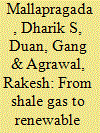| Srl | Item |
| 1 |
ID:
128380


|
|
|
|
|
| Publication |
2014.
|
| Summary/Abstract |
We present an energy roadmap for the US light duty vehicle (LDV) sector that efficiently utilizes natural gas (NG) and transitions to renewable energy and carbon sources as they become economical. We use well-to-wheels (WTW) efficiency to compare alternative NG transportation pathways. If internal combustion engine vehicles (ICEVs) remain prevalent, then compressed natural gas (CNG) is the favored fuel. Among electric powertrains, centralized electricity generation with battery electric vehicle (BEV) is more efficient than on-board generation with fuel-cell vehicles (FCV). Plug-in hybrid electric vehicles (PHEVs) balance driving range against WTW efficiency, and provide flexibility in sourcing electricity from different energy sources. Despite these efficient WTW pathways, supplying NG for the LDV sector is estimated to decrease the lifetime of current US NG reserves to about 60 years. Beyond this period, compressed methane derived from biomass can replace CNG, and utilize the would-be developed CNG infrastructure. The LDV biomass requirement depends on the biomass to methane carbon conversion and battery storage capacity of CNG PHEVs. Converting biomass to methane using solar heat/H2 leads to ~65% lower LDV biomass requirement compared to standalone processes recovering ~30% biomass carbon as methane. The resulting biomass amounts compare favorably with future US biomass supply projections.
|
|
|
|
|
|
|
|
|
|
|
|
|
|
|
|
| 2 |
ID:
180158


|
|
|
|
|
| Summary/Abstract |
Highway fast-charging (HFC) stations for electric vehicles (EVs) are necessary to address range anxiety concerns and thus to support economy-wide decarbonization goals. The characteristics of HFC electricity demand – its relative inflexibility, high power requirements, and spatial concentration – have the potential to adversely impact grid operations as HFC infrastructure expands. Here, we investigate the impacts of scaled-up HFC infrastructure using an operations model of the 2033 Texas power grid with uniquely high spatial and temporal resolution. In the reference EV penetration case corresponding to 3 million passenger EVs on the road, we find that grid-HFC interactions increase system annual operational costs by 8%, or nearly $2 per MWh of load served. Greater impacts are observed for higher EV penetration cases. The high spatial resolution of the analysis reveals that the majority of increased costs can be attributed to transmission congestion on feeder lines serving a minority of HFC stations. Four-hour battery energy storage is shown to be more effective than demand flexibility as mitigation, due to the long duration of peak charging demand anticipated at HFC stations. Transmission network upgrades can also effectively mitigate grid-HFC interactions. Choosing the most effective mitigation strategy for each station requires a tailored approach.
|
|
|
|
|
|
|
|
|
|
|
|
|
|
|
|